Introduction
Definition of Life
Motivation
Preliminary
Steps
Present Life
Past Life
Geological Survey
Sample Collection
Spectroscopic Analysis
Organic Analysis
Biology Experiments
Thin Section
Isotope Analysis
Experimental Design
Gas Chromatography/Mass Spectrometry (GC/MS)
Gas chromatography coupled with mass spectrometry is a powerful, quick, and convenient tool for organic analysis. An unknown sample of volatile gases is injected into a gas chromatograph producing a separation the basic individual gases with respect to time versus the absorption the gases. Next, these isolated gases are injected into a mass spectrometer where they pass through an ion source, mass analyzer, and ion detector to produce a spectrum of elemental mass versus the abundance of the elements. This is a typical flow chart of Gas Chromatography (http://depts.washington.edu/spectral/massspec/GCMSintro/GCMS_1.html):
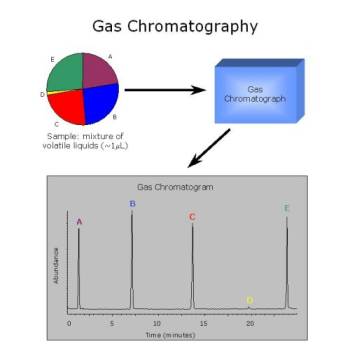
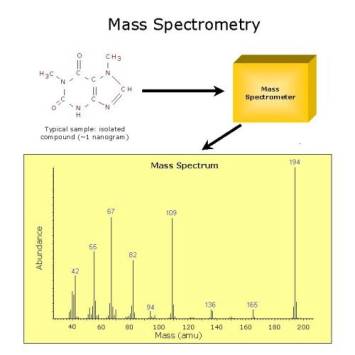
- Analytical Information from GC/MS: Material identification - The mass spectrum of the unknown compound can be searched against our computerized reference library of over 300,000 spectra for identification.
- Sample Requirements for GC/MS: Physical State - Sample must be either a liquid or a gas for a direct injection. The compounds off gassed by a solid can be analyzed using headspace analysis. Sample size - several micro liters for a liquid or a gas, between 0.5 - 1 gram for headspace analysis of a solid.
- Supplemental Information: Typical Analysis time - 1 hour the analysis and interpretation of a sample containing relatively few compounds. More complex samples will require additional time for interpretation. Unique Capabilities -separates and identifies the components of a mixture, also quantifies known compounds.
Gas Chromatography is the separation of a mixture of compounds (solutes) into separate components, which then can me analyzed by a Mass Spectrometer to give us detailed empirical molecular information regarding the chemistry of the samples. In gas chromatography (GC), the sample is vaporized and injected onto chromatographic columns and then separate into many components. The elution is brought about by the flow of an inert gaseous mobile phase. Carrier gases, which compose the mobile phase of GC, include helium, argon, and nitrogen. And the stationary phase of GC is a solid or liquid with a large surface where the absorption of the solutes takes place.
The basic components of the GC include the carrier gas supply, the sample introduction system, and the detection system. GC has a gaseous mobile phase, the carrier gas, a column containing the stationary phase and a injector for sample introduction by syringe injection. The detectors generate a signal current requiring an amplifier for output to produce the chromatogram. Diagram of GC (http://members.kr.inter.net):
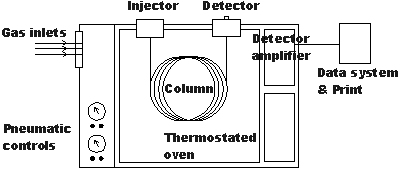
Another version of the diagram of the components of a GC system (http://depts.washington.edu/spectral/massspec/GCMSintro/GCMS_1.html):
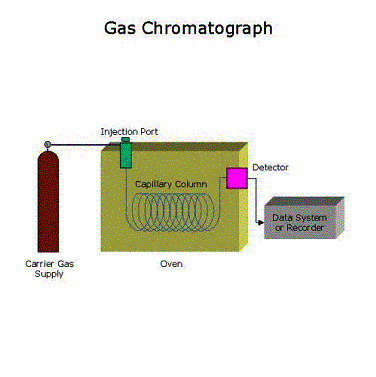
Mass spectrometers measure the mass-to-charge ration of individual molecules that have been converted into ions and this information is then used to determine the masses of the molecules. The components of the MS and its sequential order are depicted in the following diagram: (http://depts.washington.edu/spectral/massspec/GCMSintro/GCMS_1.html):
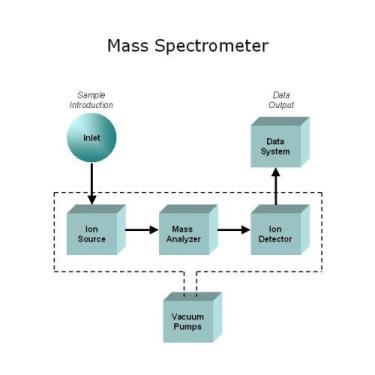
In mass spectroscopy, the sample (liquid, solid, solution, or vapor) enters the vacuum chamber through an inlet and depending on the sample, it may be ionized if it already isnít. The ions are sorted in the mass analyzer according to their mass-to-charge ratios and then collected by a detector where the ion flux is converted to a proportional electrical current that is used to produce a mass spectrum.
Functionality
GC/MS will be used on Mars in an effort to explore the chemistry of the
subsurface. It is one of the intermediate steps in the search for life
where interesting samples will be analyzed to determine is further testing
on the sample is necessary and useful as determined by the scientists on
Mars and standard protocols.
The GC/MS system will be stationed in the laboratory habitat on Mars and if possible on at least one LMR.
Weight of GC/MS: approximately 70-140 kg
Cost of one GC/MS: $50000-$150000